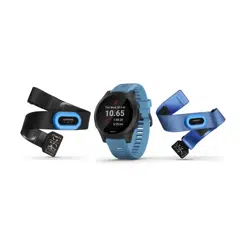Loading ...
Loading ...
Loading ...

Data Storage
The heart rate monitor can store up to 20 hours of data in a single activity. When the heart rate monitor memory
is full, your oldest data is overwritten.
You can start a timed activity on your paired Forerunner device, and the heart rate monitor records your heart
rate data even if you move away from your device. For example, you can record heart rate data during fitness
activities or team sports where watches cannot be worn. Your heart rate monitor automatically sends your
stored heart rate data to your Forerunner device when you save your activity. Your heart rate monitor must be
active and within range (3 m) of the device while data is uploaded.
HRM-Tri Accessory
The HRM-Swim section of this manual explains recording heart rate during your swim (Chest Heart Rate While
Swimming, page 35).
Running Dynamics
You can use your compatible Forerunner device paired with the HRM-Pro accessory or other running dynamics
accessory to provide real-time feedback about your running form. If your Forerunner device was packaged with
the HRM-Pro accessory, the devices are already paired.
The running dynamics accessory has an accelerometer that measures torso movement in order to calculate six
running metrics.
Cadence: Cadence is the number of steps per minute. It displays the total steps (right and left combined).
Vertical oscillation: Vertical oscillation is your bounce while running. It displays the vertical motion of your
torso, measured in centimeters.
Ground contact time: Ground contact time is the amount of time in each step that you spend on the ground
while running. It is measured in milliseconds.
NOTE: Ground contact time and balance are not available while walking.
Ground contact time balance: Ground contact time balance displays the left/right balance of your ground
contact time while running. It displays a percentage. For example, 53.2 with an arrow pointing left or right.
Stride length: Stride length is the length of your stride from one footfall to the next. It is measured in meters.
Vertical ratio: Vertical ratio is the ratio of vertical oscillation to stride length. It displays a percentage. A lower
number typically indicates better running form.
Heart Rate Features 39
Loading ...
Loading ...
Loading ...
